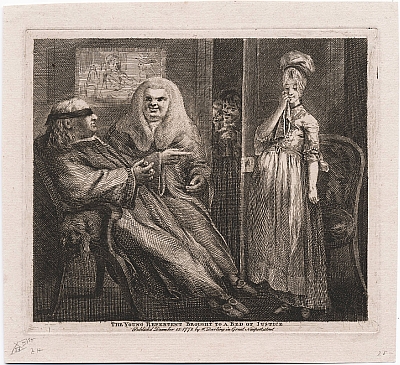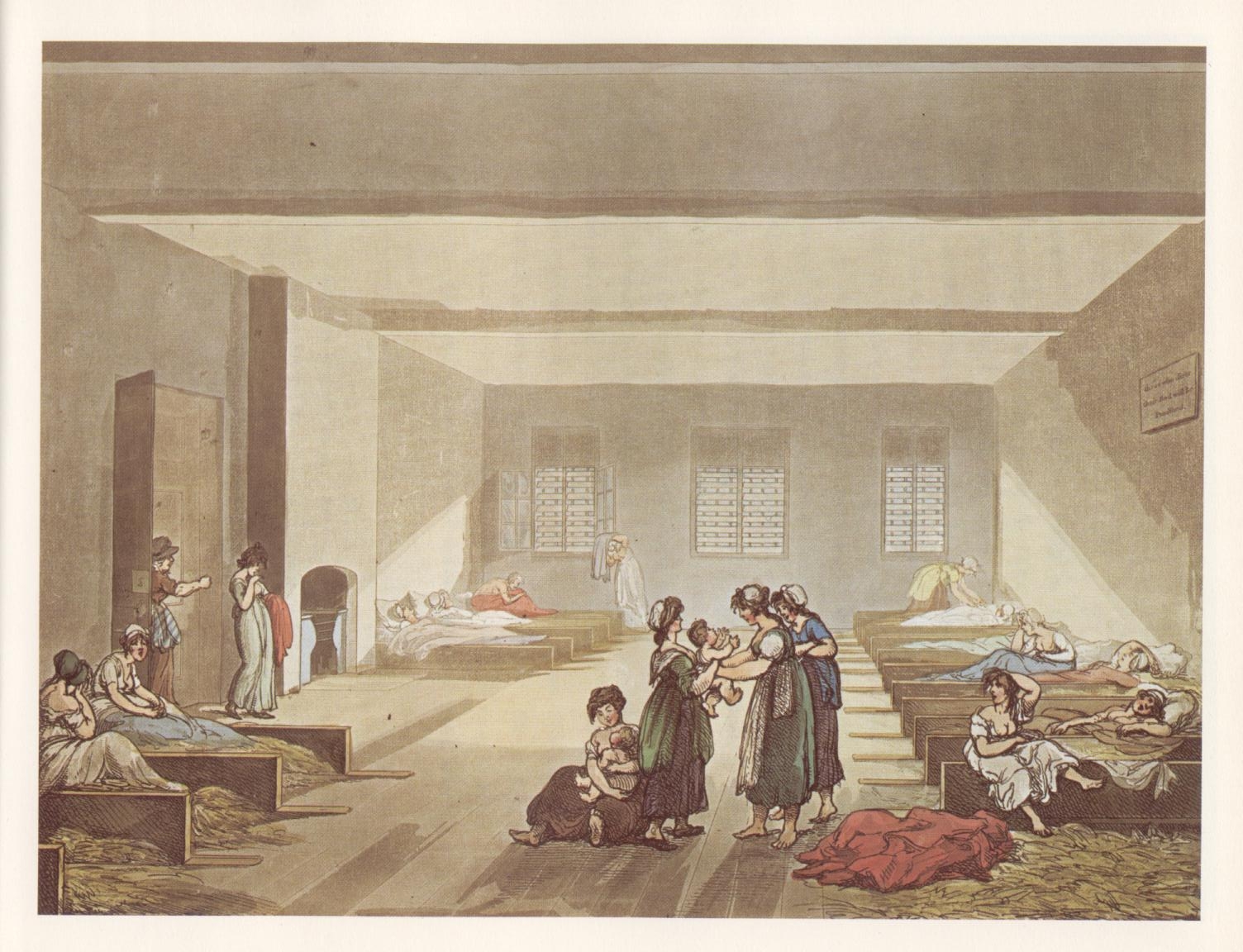Researching Bastardy
 Published by W. Darling. The Young Repentent Brought to a Bed of Justice. 1772. Lewis Walpole Library, 772.12.15.1. © Lewis Walpole Library, Yale University.
Published by W. Darling. The Young Repentent Brought to a Bed of Justice. 1772. Lewis Walpole Library, 772.12.15.1. © Lewis Walpole Library, Yale University.
Introduction
London Lives includes a wide range of sources for the history of illegitimacy in the eighteenth century. These shed light on the circumstances in which extra-marital sex took place, the birth and care of poor illegitimate children until they were old enough to be apprenticed or sent to work, and the lives and social networks of their mothers and fathers. There are significant records created by the parishes, sessions, and Bridewell, created in the process of administering both the poor law and criminal justice.
Examining Bastardy
Many records relating to bastardy in London Lives were created by parishes and are primarily concerned with establishing (or avoiding) responsibility for providing for a bastard child under the Poor Law. These essentially legal and administrative processes nonetheless generated a rich web of records, some of which foreground the voices and personal experiences of poor young women and men.
 Westminster Archives Centre, St Clement Danes, Examinations Book, 1792-1798, Ms B1203, LL ref: WCCDEP358280115.
Westminster Archives Centre, St Clement Danes, Examinations Book, 1792-1798, Ms B1203, LL ref: WCCDEP358280115.
Bastardy examinations constituted a significant proportion of all Pauper Examinations (EP). London Lives includes two long series of examinations for the parishes of St Clement Danes and St Botolph Aldgate, covering c.1740 to 1800, and a Register of Pauper Settlement and Bastardy Examinations (RD) for St Clement Danes, 1703-07. It also includes an Additional Dataset containing settlement examinations for the parish of St Martin in the Fields.
Firstly, efforts were made to discover the identity and whereabouts of the child's father in the hope that he could be made to provide for the child. The website includes a series of Bastardy Bonds (WB) for the parish of St Dionis Backchurch and a Register of Securities (RR) for St Clement Danes that record this process.
Secondly, parish officials enquired into the settlement of the mother and, in examinations taken following the birth, the child. Illegitimate children did not derive settlement rights from their father or mother, but from their birthplace; therefore it was in parish officials' interests to discover whether a pregnant single woman could be removed to another parish before her child was born, or if a bastard child could be removed to its parish of birth. This website includes a register of St Clement Danes Removal Orders (RV) for 1752-93, and references to removals are also scattered through Vestry Minutes (MO) and other parish Minute Books (MO).
As in other cases, the receiving parish could appeal against removal orders to the magistrates in sessions, and men accused of fathering a bastard child sometimes similarly disputed the allegations. Disputed cases often provide additional information to that provided in the parish documents. Records of these appeals can be found in the sessions papers for Middlesex, Westminster and the City of London, and in the Order Books (GO) for Middlesex. They may also be mentioned in Churchwardens' Accounts (AC) and Miscellaneous Parish Account Books (AO).
Parish Support
Many of the records of parish relief contain evidence of the support provided to bastard children whose parents were too impoverished to support them.
Their mothers, as mostly healthy young women, received less parish relief as they were usually expected to find work once they had recovered from the birth of the child. However, they often received parish assistance with the expenses of giving birth, and these expenditures, as well as payments made for their children's relief and contributions received from fathers, are recorded in documents including Churchwardens' Accounts (AC), other Parish Account Books (AO), and Vestry Minutes (MV). If mothers were admitted to the workhouse for the lying-in, they may also be recorded in Workhouse Registers (RW) and Lists of Workhouse Inmates (LW).
 Thomas Rowlandson, The Passroom at Bridewell, from The Microcosm of London (1808). © London Lives.
Thomas Rowlandson, The Passroom at Bridewell, from The Microcosm of London (1808). © London Lives.
London Lives includes several series of parish records that were specifically concerned with the parish's pauper infants and children, including bastards, which often also recorded some information about the children's parents. Young children were often placed in the care of parish nurses, or admitted to the workhouse, in order to enable their mothers to return to work. Document types which recorded these events include:
- Books of Children Put out to Nurse at Enfield (BE)
- Clothing Books, With Names of Children at Nurse (BN)
- Clothing Books (BC)
- Workhouse Registers (RW), as well as the workhouse registers of St Martin in the Fields and of St Luke Chelsea.
In addition, parliamentary reforms towards the end of the eighteenth century generated a series of detailed parish registers of poor infants and children:
- Registers of Poor Infants (RI) (infants up to the age of four years)
- Registers of Poor Children (RC) (children up to the age of fourteen years)
- Registers of Pauper Apprenticeships (RA)
Back to Top | Introductory Reading
Criminal Consequences
Most women who bore bastards did not face legal sanctions. However, those who were deemed to be vagrants or "lewd" women, such as prostitutes, might be sent to a house of correction or Bridewell, especially during the periods in which reformation of manners campaigns were active. In London Lives records of such prosecutions and punishments may be found scattered through the Bridewell Minutes (MG), Sessions Papers (PS) and Middlesex sessions Order Books (GO).
Sometimes bastardy led to violence and tragedy, when unmarried mothers attempted to conceal their pregnancies and were accused of killing their newborn infants. Most Old Bailey prosecutions throughout the eighteenth century were conducted under the infanticide statute of 1624 that held that those who concealed the deaths of new-born bastard children were presumed to have killed them.
These cases should not be assumed to be represent the normal experience of bastardy, but nonetheless they created highly detailed records. In manuscript records, they appear in Coroners' Inquests (IC) and Sessions Papers (PS). The trials of the accused women are found in the published Old Bailey Proceedings (OBP). The biographies of those who were convicted and executed can be found in Ordinary's Accounts (OA).
Questioning the Archive.
There is a large and growing historical literature on illegitimate motherhood in eighteenth-century Britain, and more particularly in London. But there remain several substantial gaps in our understanding of the experiences of illegitimate motherhood and fatherhood, of the life experience of illegitimate children, and of the impact of illegitimacy on the communities into which bastard children were born. The following list of questions identify some possible areas of useful research:
- Who were illegitimate mothers? What social and economic background did they come from? (Note that only poor women are likely to appear in the parish records.)
- Who were the fathers of illegitimate children?
- Did the mothers and fathers of illegitimate children come from the same social class?
- Were particular economic sectors or neighbourhoods especially affected by illegitimacy?
- What were the life chances of illegitimate children?
- How did illegitimate children fare by comparison to other children provided for by the parish?
- What was the relationship between illegitimacy and courtship and irregular marriage?
- Did becoming the parent of an illegitimate child affect the economic prospects of mothers and fathers?
- How did the birth of an illegitimate child affect the social support networks of the mother? and the father?
- Did illegitimacy affect relationships between parents and children?
Back to Top | Introductory Reading
Exemplary Lives
Lives using the keywords Bastard Child:
Lives using the keywords Mother Bastard Child:
Lives using the keywords Father Bastard Child:
Lives using the keyword Infanticide:
Lives using the keyword Prostitute:
Introductory Reading
- Black, John. Illegitimacy, Sexual Relations and Location in Metropolitan London, 1735-85. In Hitchcock, Tim and Shore, Heather (eds). The Streets of London : from the Great Fire to the Great Stink. 2003.
- Evans, Tanya. Unfortunate Objects: Lone Mothers in Eighteenth-Century London. Basingstoke, 2005.
- Hitchcock, Tim. "Unlawfully begotten on her body": Illegitimacy and the Parish Poor in St Luke's Chelsea. In Hitchcock, Tim; King, Peter; and Sharpe, Pamela (eds), Chronicling Poverty: The Voices and Strategies of the English Poor, 1640-1840. Basingstoke and London, 1997, pp.70-86.
- Levene, Alysa; Nutt, Thomas; and Williams, Samantha (eds). Illegitimacy in Britain, 1700-1920. Basingstoke, 2005.
For further reading on this subject see the London Lives Bibliography